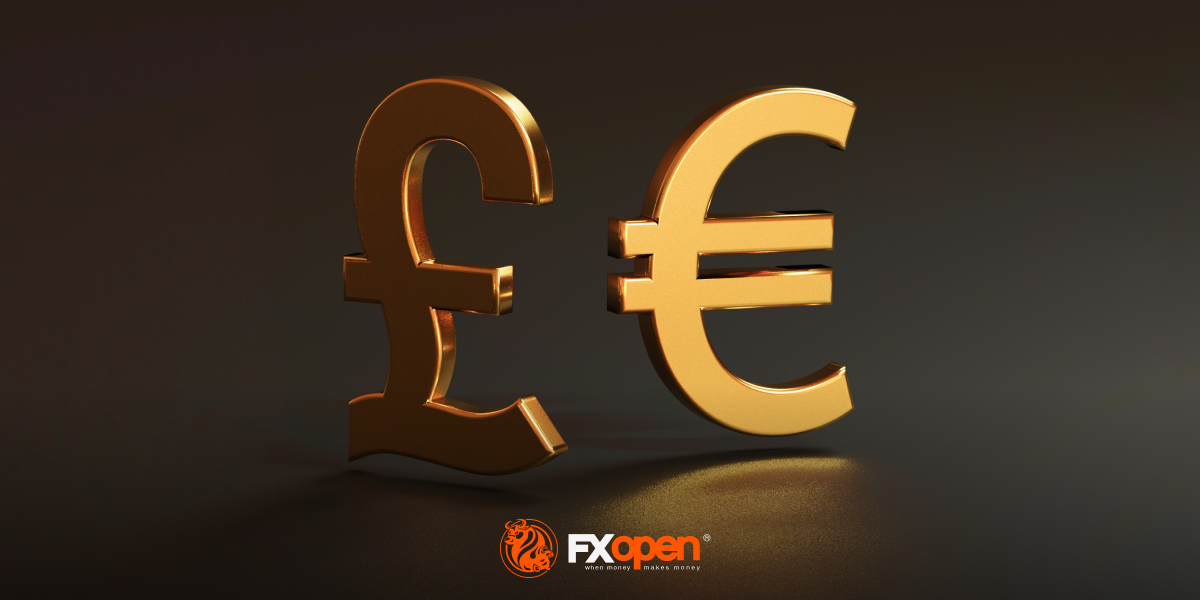Analytical EUR to GBP Price Forecasts for 2025 and Beyond

The EUR/GBP exchange rate reflects the relationship between two major global economies, the Eurozone and the UK. Influenced by monetary policies, economic performance, and geopolitical events, this currency pair offers valuable insights into broader market trends. This article explores the pair's historical performance, current dynamics, and the factors shaping its future, providing a comprehensive overview for traders and analysts.
Recent Performance of the EUR/GBP Pair
The euro and the pound sterling are two of the worlds most widely traded currencies, each representing regions with significant global economic influence. The euro, introduced in 1999, is the official currency of the Eurozone, consisting of 20 EU member states. It is a symbol of economic integration, with its value often reflecting the collective strength of its member economies.
The pound sterling, on the other hand, holds the title of the worlds oldest currency still in use, serving as the backbone of the UKs economy and maintaining historical significance as a former global reserve currency.
The EUR/GBP exchange rate has experienced strong volatility since the UK decided to leave the European Union in June 2016, causing the pound to fall sharply against the euro. EUR/GBP surged from 2016s open price of 0.737 to a high of 0.93 in October of the same year.
Between 2017 and 2019, the pair ranged between 0.831 and 0.932, reflecting ongoing Brexit negotiations and political uncertainty within the UK and the EU.
However, the official departure of the UK from the EU in January 2020 marked a pivotal moment, with markets forced to contend with this new reality.
Throughout 2020, the COVID-19 pandemic further exacerbated these economic uncertainties. The euro initially strengthened against the pound as investors rushed to the so-called safety of the euro, spiking from a low of 0.828 in February 2020 to a high of 0.949 in March before declining. By the end of 2020, the EUR/GBP was priced at 0.893.
2021 was characterised by the economic recovery post-pandemic, with both regions implementing fiscal stimulus measures. The pace of recovery, however, was uneven, as vaccine rollouts and reopening plans varied significantly between the UK and the Eurozone. These disparities led to fluctuations in the EUR/GBP exchange rate, but with a stronger pound ultimately leading the pair to conclude 2021 at 0.84.
While the return of economic activity and the UK's efforts to establish new trade relations outside the EU influenced the EUR/GBP pair in 2022, inflation and interest rates took centre stage. Inflation in the UK and EU stood at 5.5% and 5.1%, respectively, in January 2022, with inflationary pressures exacerbated by the start of the Russia-Ukraine conflict in February.
Interest rates began to rise in both regions, with the Bank of England (BoE) beginning its hiking cycle in December 2021 and the European Central Bank (ECB) waiting until July 2022 to raise rates. Concerns about economic growth and soaring energy costs in the UK ultimately led to the euro strengthening against the pound in 2022. After the UKs mini-budget fiasco in September 2022, the pair peaked at 0.923 before closing the year at 0.884.
In 2023, the euro faced challenges due to economic slowdowns in major Eurozone economies like Germany and France, alongside falling inflation, leading to expectations of monetary policy easing by the ECB toward the end of the year. Combined with a more restrictive rate in the UK (peaking at 5.25% vs the ECBs 4.5%), this pushed the euro lower against the pound to end 2023 at 0.866.
In mid-2024, the ECB began its cutting cycle, with rates reaching 3.15% vs the BoEs 4.75% at the end of 2024, aiming to counteract low inflation and sluggish growth. This further weakened the euro against the pound.
The British pound faced a challenging year in 2024. The election of Prime Minister Keir Starmer in July brought political stability and briefly bolstered investor confidence in the UK economy. However, in October, UK Chancellor Rachel Reeves unveiled a budget that included £40 billion in tax hikesthe largest increase since 1993to support public services. This announcement triggered a depreciation of the GBP against major currencies, including the euro.
Despite this setback, the pound recovered against the euro, aided by higher UK interest rates compared to the Eurozone, which attracted foreign capital inflows. By year-end, the sterling-to-euro exchange rate hit levels last seen in April 2022, closing 2024 at 0.827.
The start of 2025 has been less than favourable for the British pound. As of 21st January, 2025, the EUR/GBP pair has climbed to levels not seen since September 2024. Sterling has been weighed down by a series of disappointing economic indicators, primarily driven by substantial tax hikes on businesses. Compounding the challenges are an upcoming inflation-linked minimum wage increase and the implementation of additional employment regulations. Meanwhile, soaring government borrowing costs continue to exert pressure on the pound, reflecting the mounting strain on the British economy.
Analytical Euro to Pound Sterling Predictions for 2025 and Beyond
The EUR/GBP exchange rate in 2025 is poised to be influenced by several key factors:
Monetary Policy Divergence
The ECB has recently reduced interest rates to 3.15% to counteract low inflation and sluggish growth, which has weakened the euro against the pound. In contrast, the BoE is expected to maintain its current policy stance, with four rate cuts already factored into 2025 economic forecasts. This divergence in monetary policy approaches is likely to impact the EUR/GBP exchange rate, possibly favouring sterling but expected to be less than in previous years.
Economic Performance
The UK economy is suffering from poor economic data and a rising debt burden, which is impacting its performance. The Eurozone also faces challenges, including economic weakness in France and Germany. However, a rebound in countries like Spain, Italy, and Greece is anticipated to potentially support the euro.
Political Developments
Political uncertainty in France and Germany pose headwinds for the euro. In the UK, the recent change in government has contributed to a more favourable outlook for the pound.
Global Trade Dynamics
Potential US tariffs are expected to hurt the Eurozone's economy, which could negatively impact the euro. The impact on the UK is less clear, but it remains a factor to watch in 2025.
In essence, the relatively stronger stance of the BoEs monetary policy and economic performance could support the pound vs the euro in 2025, given the ECBs steeper interest rate cuts, political challenges, and possible tariff impacts.
To take advantage of changes in the EUR/GBP interest rate, head over to the TickTrader trading platform.
Note: these are close prices at the end of the quarter. The ExchangeRates source provides average quarterly prices.
EUR/GBP Forecasts for 2025
Q1 2025:
- Most Bullish Projection: 0.832 (Traders Union)
- Most Bearish Projection: 0.82 (Royal Bank of Canada, Monex)
Q2 2025:
- Most Bullish Projection: 0.833 (Gov.Capital)
- Most Bearish Projection: 0.80 (Monex)
Q3 2025:
- Most Bullish Projection: 0.84 (Royal Bank of Canada)
- Most Bearish Projection: 0.80 (Monex)
Q4 2025:
- Most Bullish Projection: 0.85 (Royal Bank of Canada)
- Most Bearish Projection: 0.79 (Monex)
Analytical EUR/GBP Forecasts for 2026
As we look towards 2026, the EUR/GBP exchange rate will likely be shaped by several key factors, particularly the monetary policies and economic performances of the Eurozone and the United Kingdom.
Monetary Policy Outlook
The ECB has been gradually reducing interest rates, reflecting a response to subdued inflation and economic growth. Projections by the ECB indicate that headline inflation will average 1.9% in 2026, aligning with the banks target and suggesting that the ECB may maintain or further adjust its accommodative stance to support economic recovery.
Meanwhile, the BoE has indicated a series of interest rate cuts, with expectations of approximately four reductions in 2025, as inflation in the UK has been decreasing more rapidly than anticipated. However, services inflation remains elevated, which could lead to relatively more restrictive interest rates in 2026 compared to the ECB.
Economic Performance
The Eurozone is facing economic challenges, with ECB growth projections of 1.4% in 2026, indicating a gradual recovery. However, the region continues to encounter headwinds, particularly in the manufacturing and construction sectors, which may influence the euro's performance.
The UK economy is expected to experience modest growth, with GDP projected to rise by 1.25% in 2026 according to the BoE. However, inflation is anticipated by the British Chamber of Commerce to remain above the BoE's target until 2027, which could impact consumer spending and policy decisions, thereby affecting the pound's strength.
Global Economic Conditions
Divergent monetary policies among major central banks, such as the Federal Reserve potentially maintaining higher rates while the ECB and BoE adopt more accommodative stances, could lead to capital flow shifts impacting the EUR/GBP exchange rate.
Q1 2026:
- Most Bullish Projection: 0.83 (ExchangeRates)
- Most Bearish Projection: 0.793 (Gov.Capital)
Q2 2026:
- Most Bullish Projection: 0.913 (Traders Union)
- Most Bearish Projection: 0.776 (Gov.Capital)
Q3 2026:
- Most Bullish Projection: 0.824 (Wallet Investor)
- Most Bearish Projection: 0.776 (Gov.Capital)
Q4 2026:
- Most Bullish Projection: 0.904 (Traders Union)
- Most Bearish Projection: 0.785 (Gov.Capital)
Analytical EUR/GBP Forecasts for 2027
As we project into 2027 and beyond, analytical pound-to-euro forecasts see the pair as particularly influenced by the monetary policies and economic performances of the Eurozone and the United Kingdom.
Monetary Policy Outlook
Recent EBC projections indicate that inflation is expected to stabilise around the 2% target, with forecasts of 2.1% for 2027. This suggests that the ECB may be less inclined to cut interest rates towards the end of 2026 and into 2027 if price stability is maintained.
The BoE has been closely monitoring inflation trends, with recent reports indicating that inflation is expected to remain above the 2% target until early 2027. This persistent inflationary pressure may influence the BoE's monetary policy decisions, potentially leading to a cautious approach to adjusting interest rates.
Economic Performance
The Eurozone's economic growth has been revised downwards by the ECB as of December 2024, with GDP growth forecasts of 1.3% in 2027. Concerns around fiscal constraints and external economic pressures may impact the euro's performance against the pound.
The UK economy is projected to experience moderate growth, with GDP expected to grow by 1.5% in 2027 according to the Office for Budget Responsibility. However, concerns over productivity remain, as recent reports indicate that UK productivity has been lagging behind that of the EU and the US. This productivity gap could influence the UK's economic competitiveness and, consequently, the strength of the pound.
EUR/GBP Forecasts for 2028
General Factors Influencing the EUR/GBP Pair
The EUR/GBP exchange rate is influenced by a myriad of factors that can drive its fluctuations. Below are key factors that specifically impact this currency pair:
- Monetary Policy Decisions: The ECB and BoEs interest rate decisions directly impact the EUR/GBP pair, as differences in monetary policy can alter investment flows between the Eurozone and the UK.
- Economic Growth Projections: Disparities in GDP growth rates between the two economies can sway the exchange rate, with stronger economic performance typically bolstering a currency's value.
- Political Stability and Policy: Events such as elections, Brexit-related developments, and fiscal policy changes can introduce volatility into the EUR/GBP exchange rate.
- Inflation Rates: Inflation disparities can influence the pair, as higher inflation in one region may lead to expectations of tighter monetary policy, strengthening the respective currency.
- Trade Balances: The balance of trade between the Eurozone and the UK affects currency value, with a higher trade surplus typically supporting a currency's strength.
- Global Market Sentiment: As both currencies are considered relatively safe compared to others, global risk sentiment can drive investors towards or away from the EUR and GBP, depending on the context. Previous crises, like the onset of COVID-19 and the 2008 crash, saw the euro appreciate against the pound, while the Eurozone crisis prompted the opposite.
The Bottom Line
From the volatility sparked by Brexit to the impacts of the COVID-19 pandemic and varying recovery paths, the EUR/GBP exchange rate has been subject to significant fluctuations. As we peer into 2025 and beyond, understanding the interplay between the Eurozone and UK's economic policies, inflation rates, and growth prospects becomes crucial for traders.
For those looking to navigate these waters with confidence, opening an FXOpen account provides the tools and insights necessary for informed trading decisions in this ever-evolving market. Trade with spreads from 0.0 pips and low commissions from $1.50 per lot. Good luck!
FAQ
What Is the GBP/EUR Forecast for 2025?
Analytical euro-to-pound sterling forecasts generally expect the euro to weaken slightly against the pound, with projections suggesting it may approach 0.80 GBP by the end of 2025. This reflects a combination of monetary policy divergence and economic factors.
Will the Pound Get Stronger in 2025?
According to analysts, the pound may strengthen in 2025, driven by the Bank of Englands more restrictive monetary policy.
Is the Pound Getting Stronger Against the Euro?
Overall, the pound has been gaining against the euro since 2023, and analysts expect this to continue in the coming years due to monetary policy differences and economic outlooks. However, recent weakness of the British pound caused by negative economic factors may change analysts forecasts.
Why Is the British Pound Historically Strong?
The British pound's strength historically stems from the UK's economic stability, political influence, and its role as a global financial centre. However, fluctuations occur due to economic indicators, monetary policy, and geopolitical events. As of mid-January 2025, the GBP has been on a downward trend against the US dollar for several months. Between October 2024 and mid-January 2025, the GBP lost about 9% of its value against the USD. The EUR/GBP pair has been experiencing significant volatility, with the pound losing approximately 2.5% of its value against the euro in the first three weeks of 2025.
Is It a Good Time to Buy Euros?
Purchasing euros might be advantageous for those expecting the pound to weaken against the euro. However, market conditions can rapidly change, and such decisions should be based on current analysis and personal financial considerations.
Read more: https://fxopen.com/blog/en/analytical-eur-to-gbp-predictions-for-2024-and-beyond/
Text source: Forex Trading Blog










